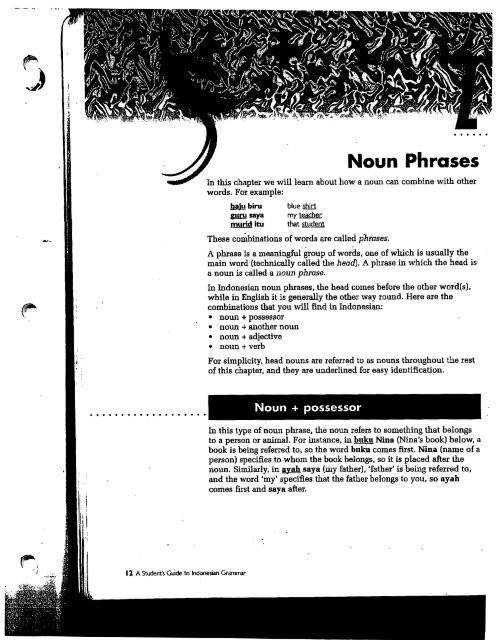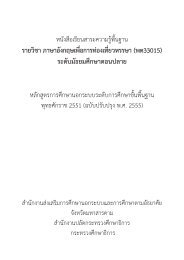- Page 1: ahasa indonesia milik widya DEPARTM
- Page 4 and 5: Contents Introduction Acknowledgmen
- Page 6 and 7: - - 14 Ter- 1 4.1 Adjective ter- 14
- Page 9 and 10: Introduction I A Student's Guide to
- Page 11 and 12: Source Acknowledgments The author a
- Page 13 and 14: Question woril: & itu apel? Is that
- Page 15 and 16: MANA Mana is used in questions, usu
- Page 17 and 18: Anda guru, bukan? You are a teacher
- Page 19 and 20: A: Karnu pernah rnakan durian? Have
- Page 21: 1 A: Murid boleh merokok di sekolah
- Page 25 and 26: 1 Post office -4 Write the Indonesi
- Page 27 and 28: ...*...**..*..* A demonstrative is
- Page 29 and 30: combining Write simple a phrases an
- Page 31 and 32: ...................................
- Page 33 and 34: U lima ratus umber word r dictionar
- Page 35 and 36: To ask questions with classifiers,
- Page 37 and 38: pertokoan di gadFio. , using lebih,
- Page 39 and 40: *'4 Work in pairs for this exercise
- Page 41 and 42: Anto duduk di kursi. Anto sits on t
- Page 43 and 44: *a*= In the verbs belajar, berenang
- Page 45 and 46: Many transitive verbs have the meN-
- Page 47 and 48: -- gel lg, request nally i also ut
- Page 49 and 50: Transitive: Andi memarahi temannya.
- Page 51 and 52: . . . * . . * . * * * * s chapter 1
- Page 53 and 54: The following verbs represent only
- Page 55 and 56: Reciprocality 'Reciprocality' means
- Page 57 and 58: act of? less ' o guess, Ingan, musu
- Page 59 and 60: isu fitnah yonis pukul mem- membisu
- Page 61 and 62: . baca to read membaca to read buka
- Page 63 and 64: uncing pointy meruncing to become p
- Page 65 and 66: MeN- verbs can be transitive or int
- Page 67 and 68: Note Sometimes we find two meN- ver
- Page 69 and 70: Anna membelikan ibunya jaket kulit.
- Page 71 and 72: Some verbs suffixed by -kan that ha
- Page 73 and 74:
-4 Interview a classmate to find ou
- Page 75 and 76:
2 ~ 4 Words with the circumfix meKi
- Page 77 and 78:
e badly rction for 'Y Some meN-i an
- Page 79 and 80:
*'' ~ranslaie the following sentenc
- Page 81 and 82:
I. scold St aach one Summary Words
- Page 83 and 84:
2 Binatang apa yang tercepat lariny
- Page 85 and 86:
1, p ject +- 4 Work in pairs, takin
- Page 87 and 88:
erdareh dingin coldblooded kas cash
- Page 89 and 90:
- C terbahak-bahak tergesa-gesa ter
- Page 91 and 92:
3 Kasihan Ani, dia menggigil ('shiv
- Page 93 and 94:
eaning xtends ep - C sore malam nig
- Page 95 and 96:
Ke-an also forms abstract nouns. By
- Page 97 and 98:
use )f a name) Uses of ke-an: Ke-an
- Page 99 and 100:
mabuk drunk pemabuk drunkard, alcoh
- Page 101 and 102:
Be careful! Although peN- and per-
- Page 103 and 104:
+& Give the peN- form of.tha follow
- Page 105 and 106:
Reduplicated nouns ................
- Page 107 and 108:
When -an is attached to some fkacti
- Page 109 and 110:
- Words with peN-an and per-an are
- Page 111 and 112:
ase word J -lu-l. A 'cry g of, meN-
- Page 113 and 114:
LATIHAN 3 Listed below on the left
- Page 115 and 116:
Dokter memeriksa pasien Subject Ver
- Page 117 and 118:
...................................
- Page 119 and 120:
Third person subject ...,.,*..*....
- Page 121 and 122:
ions ay to la1 verb Example: Bunga
- Page 123 and 124:
8 Penyelundup narkoba diperiksa Rab
- Page 125 and 126:
2 Picture A pair , . e an . lswerb.
- Page 127 and 128:
' Ayo, bersihkan mobilm . Come on,
- Page 129 and 130:
1 I really like your house. 2 Where
- Page 131 and 132:
a b Teriadinya pembunuhan itu membu
- Page 133 and 134:
Tahun lalu terjadi gempa bumi di sa
- Page 135 and 136:
Mentanementang merasa pintar, mahas
- Page 137 and 138:
Ways to Say 'If' There are various
- Page 139 and 140:
Seandainya raya milyuner, saya akan
- Page 141 and 142:
To say 'What if . . .?', we add bag
- Page 143 and 144:
Sementara means 'while' in the sens
- Page 145 and 146:
Summary Ways of saying 'when' and '
- Page 147 and 148:
Tanaman itu akan tetap tumbuh walau
- Page 149 and 150:
+4 1 1 1 1 barang berkualitas dndah
- Page 151 and 152:
..... .... ... ... ... ... .*) he M
- Page 153 and 154:
Both ... and ... / ... As Well *As
- Page 155 and 156:
A Let Alone 4 To say 'let alone . .
- Page 157 and 158:
_ Kok and born-boro are more inform
- Page 159 and 160:
Similarly, if the verb has the pref
- Page 161 and 162:
I the ed at Berdiri -. Stand up, wo
- Page 163 and 164:
lit pi: I.: similarly, the mother t
- Page 165 and 166:
1 : Did you know these different wo
- Page 167 and 168:
Very formal requests sudilah (kiran
- Page 169 and 170:
1 Invite your close friend to come
- Page 171 and 172:
)angun This word simply means 'do n
- Page 173 and 174:
' Here is a picture showing a publi
- Page 175 and 176:
Transforming subject-focus imperati
- Page 177 and 178:
LATIHAN 13 Here is an interesting s
- Page 179 and 180:
He said:'The police came to our hou
- Page 181 and 182:
There are different ways to report
- Page 183 and 184:
Mereka bertanya I siapa nama saya 2
- Page 185 and 186:
2 Picture A Picture B d MEEOONG! Su
- Page 187 and 188:
indirect speech A sentence used to
- Page 189 and 190:
meN- 68-73 adjectives 73 intransiti
- Page 191 and 192:
- - after ladv., coni .. 1 sesudah,
- Page 193 and 194:
to call forth (= cause) menimbulkan
- Page 195 and 196:
to make fun of (= mock) mengolok-ol
- Page 197 and 198:
(= ahether) apakah It's not clear i
- Page 199 and 200:
verq. much sekali He Ilks her very
- Page 201 and 202:
([trans.], =to recall, recollect. k
- Page 203 and 204:
that, those [demunstrdtive] itu. Th
- Page 205 and 206:
to turn (the face) memalingkan to t
- Page 207:
too much, if you hadn't told us thr



